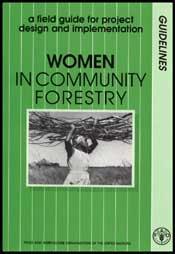 A field guide for project design and implementation - Women in
community forestry
A field guide for project design and implementation - Women in
community forestry  A field guide for project design and implementation - Women in
community forestry
A field guide for project design and implementation - Women in
community forestry
FOOD AND AGRICULTURE ORGANIZATION OF THE UNITED NATIONS
ROME, 1989
Reprinted, 1991
| The designations employed and the presentation of material in this publication do not imply the expression of any opinion whatsoever on the part of the Food and Agriculture Organization of the United Nations concerning the legal status of any country, territory, city or area or of its authorities, or concerning the delimitation of its frontiers or boundaries. |
All rights reserved. No part of this publication may be reproduced, stored in a retrieval system, or transmitted in any form or by any means, electronic, mechanical, photocopying or otherwise, without the prior permission of the copyright owner. Applications for such permission, with a statement of the purpose and extent of the reproduction, should be addressed to the Director, Publications Division, Food and Agriculture Organization of the United Nations, Viale delle Terme di Caracalla, 00100 Rome, Italy.
(c) FAO 1989
What is community forestry and why include women?
Seeing women through secondary sources
Seeing women through community observation
Seeing women in local systems
Seeing women through other disciplines
Asking women the right questions
What do women already know about trees, their products and management?
What problems are women experiencing in relation to tree resources?
What constraints do women face in addressing tree and forestry problems?
How can we find out what women know?
How can women organize themselves?
Implementing a process to include women
Annex 1 - an example from India: a women's groups' suggestions for women's participation in projects
Annex 2 - planning issues, design features and information needs of forestry project activities